Which Barrel
If you prefer keg beer to bottled beer, there are several different types of barrel available to the homebrew market and which one you choose depends upon where you are going to store it, how patient you are and how you drink your beer.
The standard 5 gallon barrel is fitted with a 2" neck and a p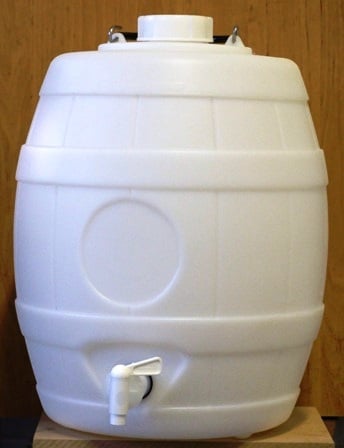 ressure vent cap. This is designed to allow any excess pressure created during the secondary fermentation to safely escape, rather than cause the tap to leak or the barrel to bulge. It has a single handle which makes it a little more difficult to lift onto a work service that is sufficiently high off the ground to allow you to get a glass under the tap for serving your beer. The quick serve tap is easy to use, but you have to remember that, when looking from above, the "off position" is with the tap at a "3 o'clock" position. If you turn the tap to a "1 o'clock" position, there is a good chance that the tap will leak. The 2" neck makes it a little more difficult to clean than the barrels fitted with 4" necks.
ressure vent cap. This is designed to allow any excess pressure created during the secondary fermentation to safely escape, rather than cause the tap to leak or the barrel to bulge. It has a single handle which makes it a little more difficult to lift onto a work service that is sufficiently high off the ground to allow you to get a glass under the tap for serving your beer. The quick serve tap is easy to use, but you have to remember that, when looking from above, the "off position" is with the tap at a "3 o'clock" position. If you turn the tap to a "1 o'clock" position, there is a good chance that the tap will leak. The 2" neck makes it a little more difficult to clean than the barrels fitted with 4" necks.
With any barrel, the beer needs to be left for at least 2 weeks after priming, to clear and to generate the gas pressure needed to serve the beer. Once it has conditioned properly, the beer can be served (though the first ½ glass will be cloudy because of the sediment that will be present in the tap chamber), but you will need to open the tap slowly in order to avoid ending up with a glass full of froth and an inch or two of beer at the bottom. If you pull too many pints out in quick succession, you will deplete the available gas and the pressure drops. If it drops too far, there is a risk that you will create a partial vacuum in the barrel and start to suck in air from outside. If this happens, you run the risk that your beer will go stale pretty quickly and you are left with only two real choices.
If there is only a small amount of beer left in the barrel, you can unscrew the lid to equalise the pressure and then allow the last few pints to be drawn out under gravity. They will be flat, but it's better than letting them go bad. Alternatively, if you have a gas injection lid, you can inject some more gas into the barrel and carry on serving your beer as normal. For more information on the different gas injection systems available, please see the "gas injection systems" topic in the FAQ list.
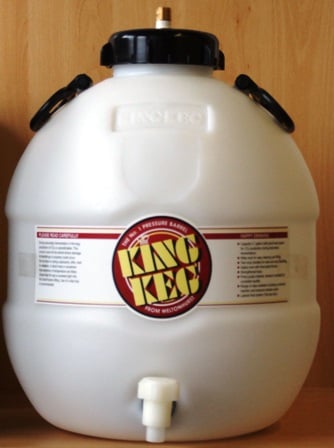 King kegs, whilst more expensive than standard barrels, are much sturdier and come complete with two handles, which makes it easier to balance the 25kg+ weight they contain when lifting them into their serving location. they are also fitted with a 4" neck that is wide enough to get your arm inside and thus makes it MUCH easier to clean than barrels with a 2" neck. They are also supplied pre-fitted with a gas injection lid, so you always have the ability to add extra gas if your pressure drops.
King kegs, whilst more expensive than standard barrels, are much sturdier and come complete with two handles, which makes it easier to balance the 25kg+ weight they contain when lifting them into their serving location. they are also fitted with a 4" neck that is wide enough to get your arm inside and thus makes it MUCH easier to clean than barrels with a 2" neck. They are also supplied pre-fitted with a gas injection lid, so you always have the ability to add extra gas if your pressure drops. 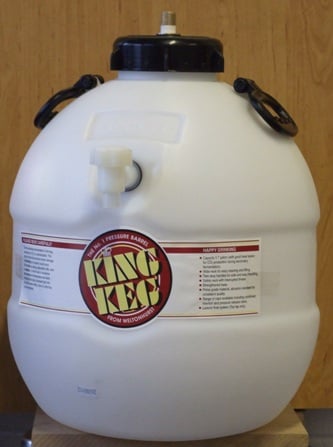 A top tap version of the king keg is also available. In this one, a float system is fitted into the back of the tap and sits on the surface of the beer. This system is useful if you are limited for space or are unable to lift a full barrel of beer. Having the tap at the top allows you to sit the barrel on the floor but still be able to get your glass under the tap to serve your beer. The only real downsides of this system are that because the beer clears from the top downwards, the float always sits in clear beer and you are thus tempted to drink your new brew before it has had sufficient time to mature and condition properly, and also the fact that you always need pressure to serve the beer as the beer level is always liekly to be below the level of the tap. This means that you are MUCH MORE likely to need to inject extra gas into a Top Tap keg than you are into a bottom tap keg.
A top tap version of the king keg is also available. In this one, a float system is fitted into the back of the tap and sits on the surface of the beer. This system is useful if you are limited for space or are unable to lift a full barrel of beer. Having the tap at the top allows you to sit the barrel on the floor but still be able to get your glass under the tap to serve your beer. The only real downsides of this system are that because the beer clears from the top downwards, the float always sits in clear beer and you are thus tempted to drink your new brew before it has had sufficient time to mature and condition properly, and also the fact that you always need pressure to serve the beer as the beer level is always liekly to be below the level of the tap. This means that you are MUCH MORE likely to need to inject extra gas into a Top Tap keg than you are into a bottom tap keg.
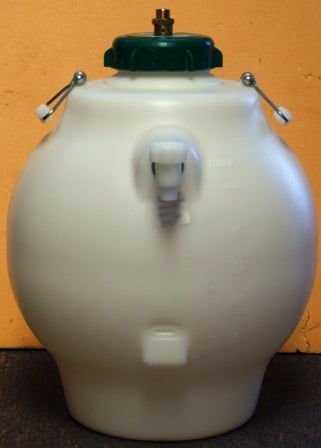
A Hambleton Bard Rotokeg also has a top tap, but has a slightly larger capacity than a King Keg and is a much more rounded shape. It is also fitted with a moulding point that allows you to attach a drip tray. It is often used by All grain brewers because of its larger capacity allows you to make and store slightly larger batches (6 gallons rather than 5) for the same amount of effort.
A completely different type of "barrel" is a Cornelius Keg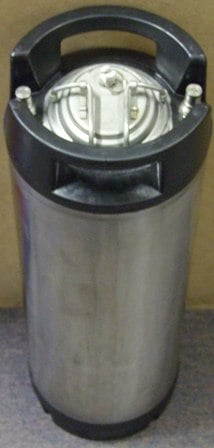 , which is usually a reconditioned, stainless steel, container that has previously been used in the drinks trade to store the syrup concentrate that is used to create the draught fizzy drinks in pubs, bars and restaurants.
, which is usually a reconditioned, stainless steel, container that has previously been used in the drinks trade to store the syrup concentrate that is used to create the draught fizzy drinks in pubs, bars and restaurants.
Unlike standard plastic barrels, cornies are designed to work at much higher gas pressures (up to 100psi compared to the 8-12psi that plastic barrels operate at) and thus require a different gas injection system, though SOME are available that have been converted to accept a standard pin or S30 style valve. They have a 4" oval neck that allows access for cleaning but require separate "in" and "out" lines fitted to it in order to inject gas and take off the beer to a tap or dispensing system. Being a steel tube, they are fairly easy to chill by putting in a bucket of iced water or upright in a spare fridge, so they are ideal for storing lager and cider. They are however considerably more expensive to set up than a standard barrel because they require additional connectors and specialist pieces of equipment that a standard barrel doesn't need.
Normally, the beer is brewed in the normal method and then transferred to a secondary fermenter for a couple of weeks to mature and drop clear. With a standard keg, you would prime the beer when adding it to a keg, but a cornie is usually used to store and dispense clear, virtually dead beer at high pressure, so it is more common to artificially carbonate it rather than naturally condition it in a sealed vessel. If you do prime it in the corny, the "out" tube attached to the tap is at the very bottom of the keg and continually sucks up any sediment formed.
As with much in brewing, each system has its advantages and disadvantages, and it is really, once again, a matter of personal preference as to which best suits your own tastes and wallet.
